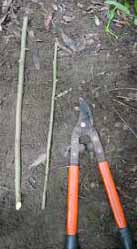Making Cuttings< previous | 1 | 2 | 3 | next >
Of particular interest for Soil Bioengineering is what can be done with the top once it has been cut from the roots. At this point it can be planted at a new site and continue growing, often faster than seedling would, and certainly with less effort and resources invested in each individual than is the case with nursery reared stock. This means that even if the success rate is lower, many cuttings can be planted inexpensively, directly into the ground on site.
_________
____3) Cut top planted and allowed to root___4) Conservative cutting without top
The third figure shows what might happen if the top which had been cut away from the tree in the first figure were immediately planted in the ground and allowed to root out. In this case the IAA from the shoots moves down towards the roots which no longer exist, and accumulates at the cut end. Without Cytokinins to cancel the IAA out, it stimulates dormant buds to form new roots, and growth resumes. Not every species is capable of doing this. Also depending on the time of year, a lot of water would need to be available to the cut top for it to succeed, and it would be quite stressed. The leaves after all would still be transpiring and loosing water even though there is not much root surface area available to replace this water. The tree would likely shed leaves to avoid excessive water loss. Removing the leaves, or cutting and planting during a dormant season would improve the results.
The final figure addresses the problems discussed in the third. Instead of leaving the top intact , a less risky more conservative method is used. The top has been cut away as well so that there are neither shoots nor roots. Now hormones in the cutting have really been thrown into chaos, however it will sort itself out. The same process occurs with new roots and shoots being formed as in the previous figures, however the shoots which develop are in proportion to what the roots can support ( and vice versa) so that stress is minimized. Cuttings produced this way should have better chances of success and require less maintenance, making it ideal for direct planting in the field. Multiple cuttings of this sort can be taken from a single plant, as each is just a short length along the stem. However care must be taken to differentiate between the top and bottom of the cutting, because if planted upside down it will die instead of growing.
Typically what is recommended for a generic cutting is to use woody stem material 1 to 3 cm in diameter, 50 to 90 cm long, cut with a flat top and an angled bottom so the ends will not be confused. The cutting should be stuck with 2/3 to 3/4 of its length underground in order to maximize the rooting potential. These rules can vary significantly depending upon the soil bioengineering technique being used. However, sharp tools should always be used so that the cuts will not be ragged, and can heal over easily.
Continued: foreign objects, wounds, and healing
< previous | 1 | 2 | 3 | next >

